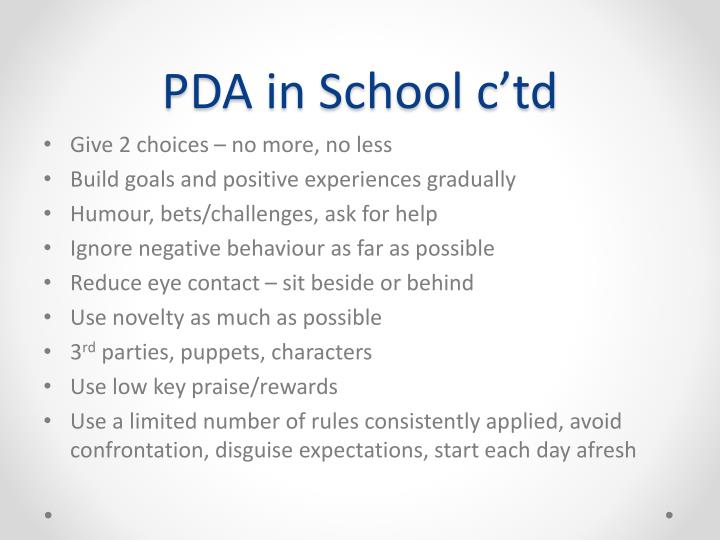

The self-harm, suicide and substance abuse rate for these students is much higher than the rest of the Autistic population. As a result, poor mental health outcomes are a common reality for the entire family, in extreme cases, families have had their children removed (again from a lack of understanding of this complex profile) or families have been forced to give up their children in order to protect other children/family members. Due to a lack of understanding and awareness of this profile from schools, practitioners and the general community, families tend to become extremely isolated, many become broken and disconnected from society. The culmination of several years of negative school experiences shows a pattern leading to complex trauma and most families are left with no option but to home-school. The meltdowns/panic attacks that PDA students experience can pose a risk to themselves and others as they are operating from the fight/flight response and have no control over their actions/behaviour. Research shows the students experience high levels of school refusal, increased experiences of discrimination, seclusion and exclusion. The way our school systems are traditionally designed and structured do not meet the needs of students with a PDA profile. How can this impact a student’s experience of school?


Looking at several pieces of research exploring the prevalence rate, they report between 1-4%.

Therefore, an accurate prevalence rate is yet to be defined. The research is in it’s infancy, having begun in the 1980’s in the UK by psychologist Elizabeth Newson. How common is the profile for children experiencing ASD? This poses a multitude of challenges for the education system to meet their needs. Many of these approaches trigger the oppositional behaviour and lead to the student experiencing meltdowns on a regular basis which can lead to traumatic school experiences. The behaviour profile is not responsive to traditional, more conventional strategies and methods or working with Autistic students. The oppositional behaviour of the PDA student is in not in their control and is a direct result of their disability. Pathological or Extreme Demand Avoidance (PDA) is a profile on the autism spectrum, involving the avoidance of everyday demands and the use of ‘social’ strategies as part of this avoidance.
PATHOLOGICAL DEMAND AVOIDANCE STRATEGIES SCHOOL PROFESSIONAL
Christina's combination of professional and personal, lived experience of disability allows her to offer unique insight, understanding and practical strategies. She provides seminars, professional development sessions and speaks at conferences all over Australia. Christina currently works as an Autism & Neurodiveristy Educational Consultant through her business, Neurodivergent Mum. She is the proud parent of 2 neurodivergent children who fit the PDA profile and was diagnosed after her children. The chapter summaries and simple activities listed throughout make this a useful tool for busy teaching staff working with PDA pupils.Christina Keeble is an Autistic & ADHD teacher with a Master in Special Education, a background in Psychology and experience working in special education settings since 2003. It covers key issues for children with PDA, such as sensory issues, preferred language and phrasing of demands, social skills, and recognizing distressed behaviour. The activities presented aim to make children more comfortable and at ease, and therefore better able to learn. Beginning with an introduction to PDA and how it can affect the education experience, it is then followed by thoughtful, useful strategies school staff can implement to build a collaborative relationship with pupils and help them to thrive in the school environment. This essential guide for working with PDA pupils outlines effective and practical ways that teachers and school staff can support these pupils, by endorsing a child-led approach to learning and assessment. Teacher's Introduction to Pathological Demand Avoidance: Essential Strategies for the Classroom


 0 kommentar(er)
0 kommentar(er)
